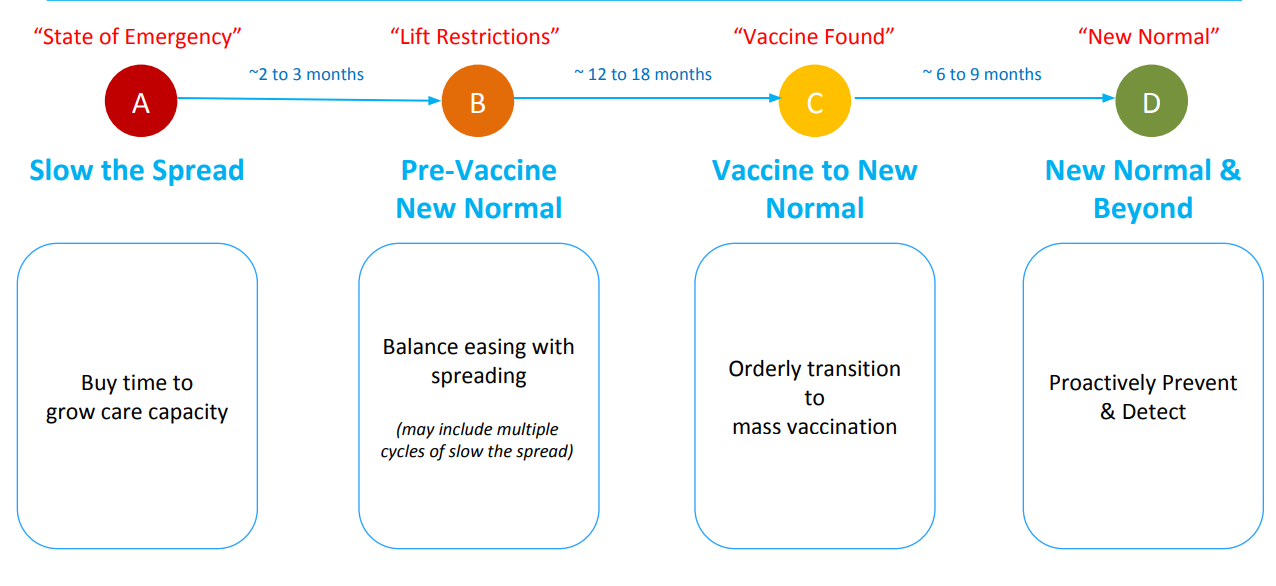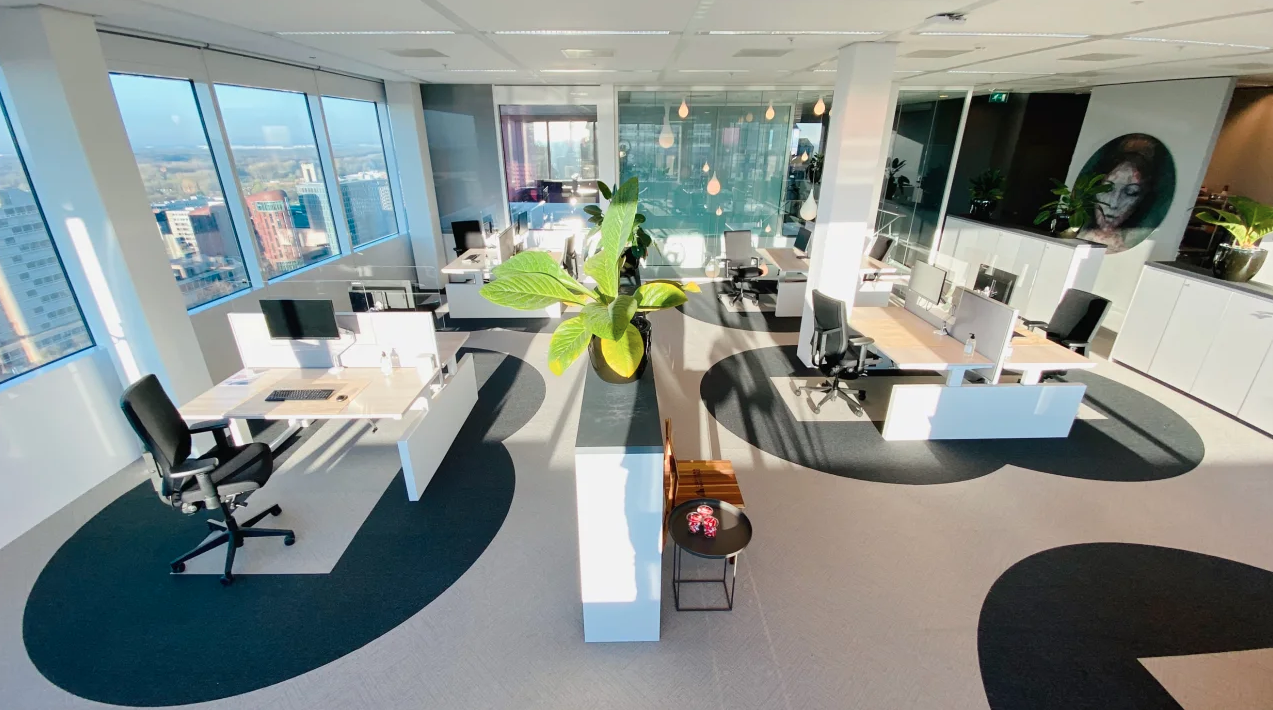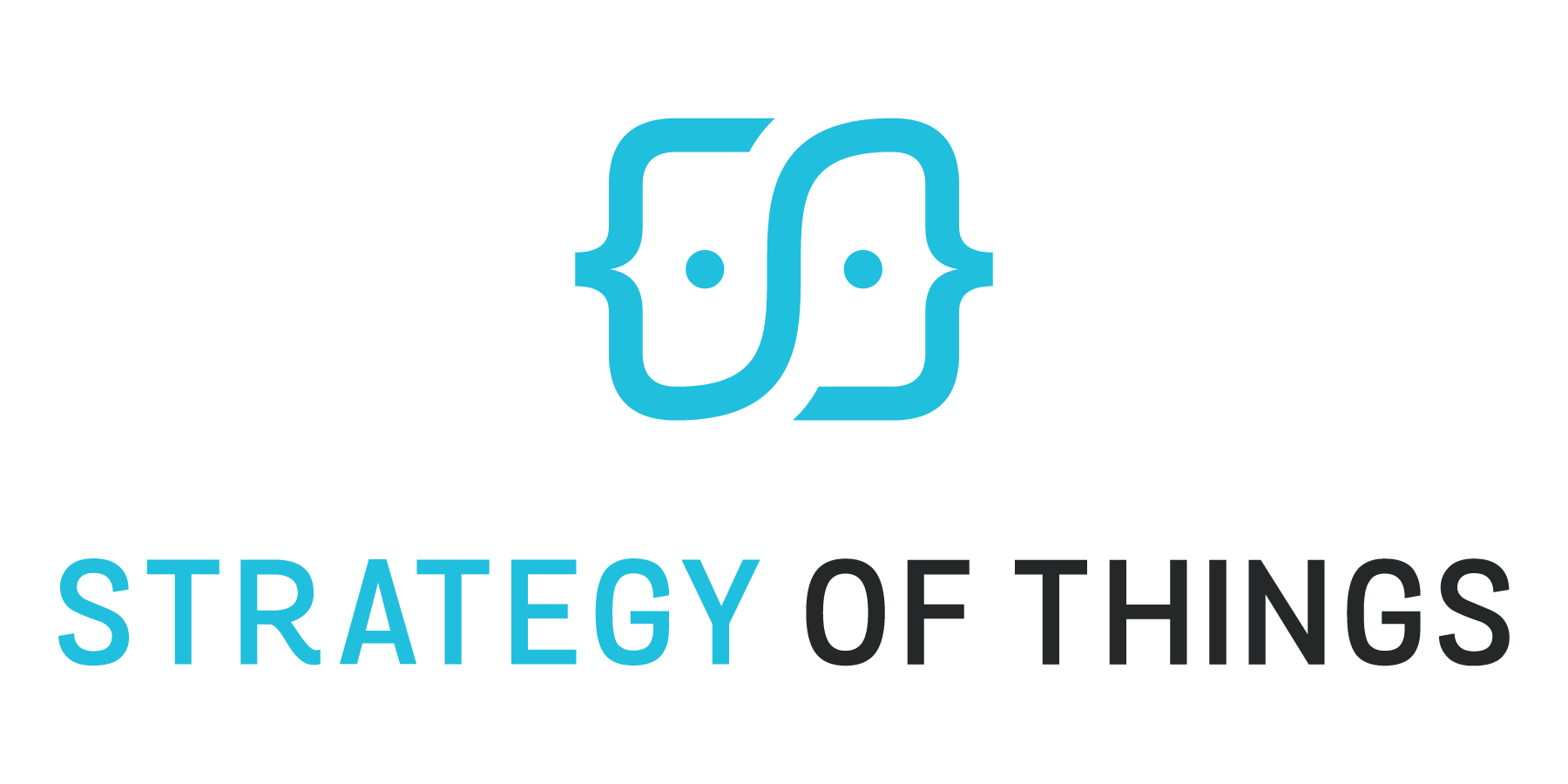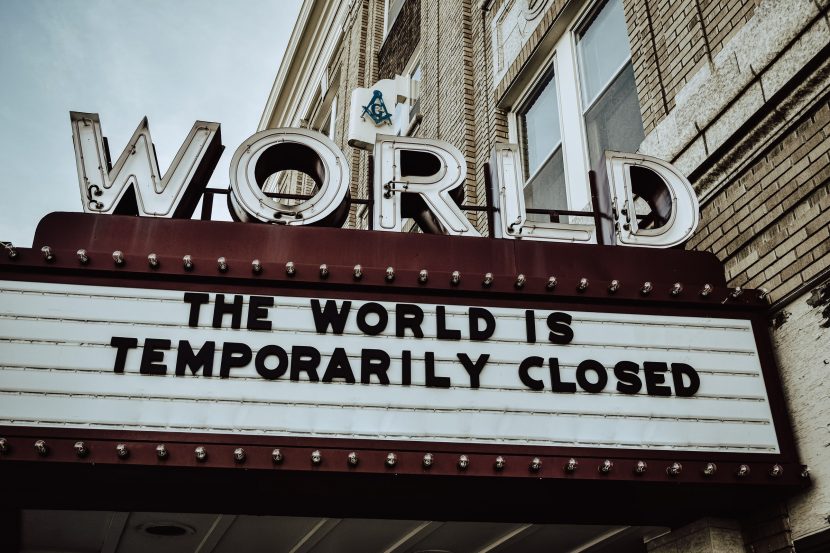COVID-19 deaths in the United State topped 65,000 on the May 1st, the equivalent of wiping my entire hometown of Danville, California off of the map, with an extra 15,000 deaths thrown in for good measure. The virus now kills as many Americans as cancer and heart disease each day. As the country, and the world, enter various levels of lockdown, we find ourselves trapped inside with our families and roommates, searching for fragments of positive news that could point to a possible path back to normalcy.
In uncertain times, humans rely on optimism. We cling to every news article that highlights a potential vaccine or suggests that the curve may be flattening. Unfortunately, the reality is not as simple. We will see a return to normalcy. However, our interpretation of “normal” will change decidedly.
Four Key Steps
The foreseeable future will be broken down into four steps. We are currently in the first step, where the name of the game is to slow the spread in order to buy time for our medical system to manage caseloads, avoid overcrowding, and increase capacity to care for the ill.
The second step is the pre-vaccine COVID-19 New Normal – an interim period whereby some restrictions will be eased but most high-risk activities will be prohibited.
Once a vaccine is developed, likely a year or more from now, we will have begun the third step. In this phase, we are moving towards a more standard vision of normal. However, it will take time for sufficient vaccine deployment to achieve critical mass in the population. Moderna, one of the highest-capacity biotech companies in the world, has estimated that they could produce 100 million doses of vaccine per year.
The fourth step is then implemented as society continues to evolve and adapt to the “new normal”.

Figure 1: The COVID-19 Journey Ahead of Us. Source: Strategy of Things, https://strategyofthings.io/
A New Concept of Normal
But what will this new normal look and feel like? To answer these questions, it is crucial that we look through the lens of those on the ground who will be most affected. On the one hand, cities are hotbeds of contagion – look no further than New York, with a population density of 27,000 people per square mile, which is currently being battered by the coronavirus to the tune of more than 250,000 cases and nearly 20,000 deaths.
On the other hand, higher densities in urban areas are crucial to allowing access to goods and services, reducing greenhouse gas emissions associated with driving, preserving agricultural land from suburban sprawl, and providing sufficient housing capacity for a rapidly ballooning global urban population.
The dichotomy between the clear overarching benefits of increased population density and its specific and deadly drawbacks will likely be a catalyst for a wide-reaching and paradigm-shifting revamp in how we think about urban planning and development in the future.
In the interim period between now and a widely-available vaccine, however, other major shifts will take place that will significantly impact how we conduct business and interact with each other. The significance of these impacts will be determined by our testing and tracking capacity, which is still sorely lacking.
To illustrate the coming alterations of our normal lives, we’ve taken a deep dive into a few staples of day-to-day life that will bear the brunt of the effects of this pandemic, and how they will adapt to a changing world.
Restaurants
The restaurant industry, America’s second largest private industry behind healthcare, will be among the hardest hit due to the tendency for patrons to be seated in close proximity to each other and the already razor-thin profit margins. City restaurants, once bustling with diners, will see a dramatic change in business models and operations as American consumption habits alter significantly.
Many in the industry will not recover – the National Restaurant Association has estimated that up to fourteen percent of the nearly one million restaurants in the United States will permanently shutter this month, a figure that could ultimately rise to claim the lives of one-in-five American restaurants and the jobs of more than three million restaurant workers. The decline will hit these workers especially hard – 40% of waiters and waitresses already live in poverty, with more than half of their earnings coming from tips – this comes largely as a result of the low federal minimum wage for tipped workers, frozen at $2.13 since 1991.
However, low wages are not the only source of anxieties for food service workers. Many workers do not receive healthcare benefits from employers, and few – just 25% – are granted paid sick leave. As these employees are forced onto the front lines as “essential workers” and make headlines as one of the hardest-hit but most crucial sectors of the workforce, it is likely that we will see a revamp of federal and state wage laws.
Lockdowns will not affect all restaurants equally. Chain restaurants, with legal teams and greater resources, are more likely to be able to take advantage of federal bailout funds, as your favorite local eatery grapples with the complicated legalities of the bailouts while simultaneously struggling to make rent and drive customers into their stores.
On the Ground
Restaurant operations will change significantly as they adjust to the new normal. Restaurants will shift away from in-house dining, favoring takeout and delivery operations instead. Those who do choose to maintain their dining rooms will have to reduce capacity in order to space out their tables – this may also lead to an emphasis on outdoor or patio dining. They’ll also likely move away from shareable dishes in an attempt to reduce cross-contamination.

Figure 2: Restaurants have begun to shift to takeout and delivery options. Source: Sean Kilpatrick/Canadian Press https://seankilpatrick.photoshelter.com/about/index
These establishments will likely be forced to make a number of changes in order to protect their staff and customers. California governor Gavin Newsom mused on the expected changes in a news conference, saying customers may see “waiters wearing gloves, maybe a face mask” and will likely have their temperatures taken at the door. Other safety measures we are likely to see include plexiglass dividers to separate workers and customers, individually-wrapped utensils for takeouts and deliveries, and disposable menus, one of the most surprisingly dirty items in most restaurants.
Technology, already prevalent in the industry, will be even more crucial. Apps facilitate ordering from distance and contactless payments can speed up transactions and reduce the need to make physical contact with workers or credit card readers. Technology-based ordering will also see a rise, as fast food and chain restaurants implement “kiosks” to reduce face-to-face contact. In other parts of the world, these forms of technology are already widely-used. As the industry adapts, this technology will see new life in the USA.
Culture Change
One of the most sweeping changes we will see, however, will be a cultural shift away from restaurants in favor of home cooking. Dining out will become a special occasion as people weigh the risks of being in such a highly-trafficked environment. To combat this, restaurants will likely slash prices to compete with grocery stores. They’ll also have to get creative – already we are seeing eateries adopting grocery store-style operations of selling ingredients directly to consumers and encouraging customers to purchase gift certificates to bridge the revenue gap.
Offices and Remote Work
Working from home, a luxury once afforded to less than 4% of the workforce, could expand as high as 30% as experts warn the public that the need to maintain social distancing guidelines could continue into 2022. The remote work movement has already grown by nearly 100% over the last decade and is likely to trend higher due to the inherent risks of being forced inside with numerous other workers. Work-from-home technology will be a primary benefactor, as video-conferencing software such as Zoom replaces in-person meetings. This likely won’t be temporary. Workers will become used to the comfort of their own homes and will be reticent to return to the office, so long as productivity is maintained.
Of course, only about 30% of the workforce is lucky enough to have the ability to work from home, meaning large swaths of workers will eventually return to the office in some form. When they do, the atmosphere inside will likely be vastly different from the one they left behind.
Major Changes
Physical changes will be the most apparent. Businesses are likely to rethink the modern “open-plan” office concept to reduce person-to-person contact. Separation between you and your coworkers will increase as desks are located further away and dividers block your views. Common spaces will be less prevalent and more frequently disinfected. In fact, offices in general will most likely adopt far more stringent cleaning policies, from more frequent cleanings to beefed-up HVAC systems and even the use of UV lights to disinfect. Overall, office workers can expect to be more physically and emotionally separated from coworkers.

Figure 3: The “Six Foot Office” concept reminds workers of the need to socially distance. Source: Cushman & Wakefield, https://www.cushmanwakefield.com/en/netherlands/six-feet-office
In the short term, offices are likely to adopt a series of easy-to-implement measures to curb the risks, from roped off work spaces to removing chairs in conference rooms to reduce capacity. One-way traffic flows will become to norm as offices strive to reduce the need for people to squeeze by each other in tight hallways. Door handles will be removed and the doors propped open to allow greater air flow and allow workers to avoid touching door handles.
The potential mental and productivity-related effects of this separation and operational changes will likely serve to push more companies to allow remote work, at least on a part-time basis. There will also be a logistical element to this, as greater separation between employees reduces the available workers per square foot ratio.
Mass Transit
As remote work skyrockets, mass transit use has plummeted. Nationwide, about 2% of all mass transit systems are self-sustaining, meaning the other 98% rely extensively on user fees and taxes. As a result of the pandemic, user fees generated will mirror the precipitous drop in ridership, placing more of an onus on local and state governments to prop up transit systems in order to provide transportation to essential workers.
In the long-term, governments will have to rethink guidelines and recommendations for how mass transit in their cities is designed, implemented, and operated. Fewer seats and limited capacity on trains and buses will become the norm, likely pushing transit operators to lower-capacity transit operations with higher frequency, at greater cost. The pandemic may also come with an unexpected side effect of lending credence to the largely-European practice of providing free transit to encourage ridership.
In the short-term, transit operators will need to implement a series of Band-Aid measures to rebuild trust and encourage people to return to their transit systems. Across the country, we are already seeing a number of creative solutions in the works, from netting to separate workers from drivers, sanitization of stations and buses, and even senior- and high-risk-specific transit options.
Micro-transit, once billed as the new commute, has gradually seen a decline in use across most cities, but could see a renaissance as people move away from the congested and dirty conditions of many mass transit systems across the country. Scooter and bikeshare allows people a cheap and relatively quick commute to work, especially in urban areas where car travel is impractical. As workers return to the office, look for a spike in micromobility use nationwide.

Figure 4: Mass Transit ridership has declined sharply. Source: New York Times, https://www.nytimes.com/interactive/2020/03/13/upshot/mystery-of-missing-bus-riders.html
Creative Solutions
Private companies will also likely implement their own processes for dealing with the risks associated with a high reliance on mass transit. Workers may refuse to come into work if they fear contracting the Coronavirus on a train, and requiring workers to come into the office can foster animosity towards the company and looks poor in the public eye. Instead, companies may provide private buses or shuttles for employees (as is already being done with several tech firms in Silicon Valley), or they may subsidize car leases or purchases.
Other companies will opt to shorten the commute, potentially by opening satellite locations in areas where many employees live and have cars – this is a solution that would also help to alleviate office spacing issues. Whatever the solution, mass transit will likely be viewed with suspicion for the foreseeable future.
Education
One of the first lockdown measures was the closure of schools to be replaced largely by online curriculum for the remainder of the current school year. However, these changes are unlikely to revert back to normal any time soon. Instead, online education for middle and high school students is likely here to stay. The changes to our education system will manifest in two main veins. The structure of the educational process will be overhauled, and the curriculum itself will likely be altered.
Remote Learning
Structurally, schools will have to recognize the importance of online or distance education and will have to account for it being a significant and unavoidable part of the future of education. With this will come complications as educational organizations restructure their learning processes and new technologies are developed and implemented. Already, we are seeing classes being taught via Zoom and Google Meets. Whiteboards have been replaced by Canvas; recess replaced by FaceTime hangout sessions.
With the implementation of wide spread remote learning comes equity issues, as education systems grapple with structural inequalities among students that prevent access to crucial educational tools and even internet access. To truly implement a successful and effective online education system, we will need to address how we will support the most vulnerable populations through implementations such as free or low cost laptops or district-wide WiFi access.
Curriculum Changes
Curriculum could also change as a direct result of the coronavirus. Until now, there was very little, if any, education on the impacts of diseases and the potential for pandemics to overrun the world. Personally, I was unaware of the impacts of the 1918 Spanish Flu until long after I graduated from high school. Now, however, the subject is unavoidable. Schools need to think about how to fold in crucial education about why this pandemic arose, what the failures and successes of various federal, state, and local governments have been, and how we can be better prepared to quickly and efficiently respond to similar diseases that may arise.
Operational shifts
For many children, attending school entirely or even partially online can be impossible. As a result, when schools do reopen, there will likely be significant shifts in operations. While some are more obvious, such as increased sanitizing of classrooms and public areas, others will address how the school is run. Smaller class sizes will be a necessity in order to reduce congestion inside and expand the physical distances between students. We will also likely see a shift to staggered schedules in an effort to minimize the number of kids on campus at any one time. Recesses and lunch breaks, where kids often congregate in large groups to hang out with friends, will see new rules and regulations designed to break up larger gatherings of children into smaller and more manageable groups. Sports games and assemblies will likely see similar changes.
In the short-term, a number of additional measures are likely to be taken to ease kids back into schools in a safe and efficient manner. Even if schools do reopen, states are likely to require attendance leniency for parents who do not feel comfortable sending their children to school, similar to policies enacted during the 1916 polio epidemic in New York – for those children who do attend, expect to see widespread testing in schools. It is also likely that this school year, canceled or postponed by 43 states thus far, will significantly impact how the following school year will run, with many suggesting that it could either begin early or extend into the following summer in order to make up for time lost.
Implications
While the education system itself will be disrupted, it is important to recognize the external implications of such disruptions. For many parents, school doubles as free childcare. With so many kids currently forced to continue education at home, parents are either unable to attend their jobs as essential workers, or have seen declines in productivity while their time is split between work and childcare. Looking forward, it is essential that the childcare implications of remote education are observed and addressed in a manner that will allow parents to continue to work to put food on the table and that will provide children with an enriching environment in which they can develop.
Hospitality and Tourism
Hotels, many of which have seen their revenue drop by more than half in recent months, will have to adapt accordingly. Already, large hotel chains are issuing bonds and credits to allow consumers to purchase discounted coupons for use at a future time. As more professionals work from home, some hotels are even offering up hotel rooms as work spaces.
Hotels will not all see effects of the same magnitude. “Luxury” and “upper upscale” hotels can expect to see much higher losses than “mid-tier” and “economy” hotels. Location also plays a role, with urban hotels seeing losses more than four times those of hotels in small towns.
The steep decline of the hotel industry will be mirrored by similar impacts to a tourism industry that provides nearly $9 trillion and 320 million jobs to the global economy annually. Airlines reducing flights and countries closing down borders to foreign nationals will cripple countries that rely on tourism. The US economy, which relies on tourism for nearly 10% of its GDP, will see the largest absolute losses – followed by Spain, France, and the UK. Notably, these countries are also seeing the highest rates of coronavirus, suggesting a correlation between travel and infection.
Revenue Losses and Labor Concerns
Globally, the World Travel and Tourism Council is predicting losses of 75 million jobs and a $2.1 trillion revenue hit. In the US, the tourism industry expects to lose 4.5 million jobs in May alone. The importance of the summer travel season and the risk of permanently crippled local travel industries has pushed some favorite travel locations to consider reopening against expert advice.
The impact will hit airlines especially hard, with the International Air Transport Association (IATA) predicting worldwide airline losses will top $250 billion (although some losses could be offset with the crash in oil prices), which would represent a 44% drop from 2019.

Figure 5: Changes in Airline Revenue from 2019-2020. Source: Monica Serrano, NG Staff, https://www.nationalgeographic.com/travel/2020/04/how-coronavirus-is-impacting-the-travel-industry/
Retail
The retail industry, already crippled by the virus and facing long-term decline are now on “life support” as stores close and online sales increase dramatically. Strip malls will slowly transform into ghost towns as consumers grow weary of the risks of packing into department stores and milling around shopping centers with hundreds of other people.
Those stores lucky enough to wither the pandemic will have to pivot away from checkout counters manned by employees in favor of touchless payment and self-checkout. Cleanliness and spacing will become key to encouraging customers to enter. Connection to the community will be crucial to rebuild trust in the brick-and-mortar retail concept.
The decline in physical storefronts will impact more than just retail providers. Even today, nearly 20 million Americans – 6% of the population – lack reliable access to broadband internet, a rate that is more than doubled in rural areas. Seniors are also similarly affected, with 33% of residents over 65 lacking reliable access to the internet. Nationwide, there is a strong correlation between income and internet access, with less than half of all seniors making less than $30,000 able to get online.
Contactless payment is also an issue, as 141 million Americans, or 42 percent of the population, do not own a credit card. As a result, large swaths of Americans are unable to participate in the online retail trend.
Manufacturing
Manufacturing has also taken a big hit in 2020, with 80% of manufacturers concerned about the financial impact of the virus on operations. Many have shut down as a result of stay-at-home orders – few manufacturing jobs are compatible with remote working. As some hotspots reach their peaks and begin to decline in new cases, some factories have begun ordering employees back to work, but will have to do so with an abundance of caution and a new set of regulations to ensure social distancing recommendations are met.
The Defense Production Act has offered some factories a lifeline as elected officials obligate the production of masks, swabs, and personal protective equipment (PPE), but even so, the impacts have been devastating enough to bring calls for a $1.4 trillion bailout for manufacturers and other businesses.
Reshoring and Supply Chains
For several years now, we have begun to see a phenomenon of “reshoring”, whereby US manufacturers are departing global manufacturing hubs such as China in favor of a return to American shores. In the midst of a pandemic, this trend is likely to accelerate. Some experts have predicted that reshoring will have a positive effect on US unemployment rates as jobs return to the States. Others, however, disagree with this analysis. They argue that drastic changes to the supply chain will disrupt production, especially in a time where certain products, namely PPE, are critical in the fight against the coronavirus. Reshoring could also drive up prices, as tariffs on Asian countries with low-cost labor reduce the attractiveness of outsourcing manufacturing.
Three-quarters of US companies have seen their supply chains interrupted as a result of the pandemic. Previous theories on supply chain management focused on reducing costs, but companies are now turning their focus to resilient and flexible processes in order to predict and hopefully prevent future disruptions. The result will likely be a renewed effort at regionalization as small- and mid-sized businesses attempt to reduce their vulnerability. The new normal will also bring new technological interventions in supply chain management. Companies will use AI and the Internet of Things to automate as much of the process as possible.
Wholesale Changes
The most visible industries are not the only ones taking a hard hit. Oil has just crashed below $0 per barrel, forcing oil producers to pay consumers to take oil off their hands. This will exacerbate the troubles of a fossil fuel industry in long-term decline. In the long run, this will hopefully lead to a reduced dependence on oil and other harmful fossil fuels. However, the short term effects will continue to have disastrous impacts on the global economy.

Figure 6: Oil prices have plummeted. Source: S&P Dow Jones Indices, https://us.spindices.com/indices/equity/dow-jones-us-oil-gas-index
To battle the economic effects of the pandemic, Big Government will return with force. Already, we have seen $2 trillion in government bailouts as formerly non-mainstream ideas such as Universal Basic Income take hold; still more aid is likely coming.
Lessons to Learn
During the 2008 financial crisis, one of the key stipulations of then-President Obama’s $800 billion bailout plan was a hefty $105 billion package targeted towards so-called “shovel-ready” infrastructure projects that could be implemented quickly and provide crucial jobs to an American public that had seen unemployment rates creep up to nearly 10%. While the first 2020 stimulus package, valued at $2 trillion, has come and gone without significant infrastructure investments, one rare potential source of cooperation between Democrats and Republicans could come in the form of a second, similarly valued package focused largely on infrastructure projects.
As unemployment woes continue, the American practice of tying health insurance to employment has given voice to those pushing for universal health insurance. Quantitative easing programs, whereby central banks purchase government debt to the tune of tens of billions of dollars per day in the United States, has expanded to even emerging markets such as those in Indonesia, Romania, and South Africa.
Looking Forward to our New Normal
Uncertainty is the operative word these days and unfortunately, our current situation abounds in it. As the world adapts, we will in time see a return to “normal”, but it won’t be the normal of years past. Changes are coming, as they have to, to ensure that we are not susceptible to the type of era-defining calamity which currently faces us. In the long run, this means complete overhauls of systems that we consider to be ubiquitous in normal life. The short term will bring much more superficial changes as we find level footing on uncertain ground.
Consider the occurrences of a century ago, when Americans faced World War 1, the polio epidemic, the Spanish Flu, the Great Depression, and then World War 2. That 30 year period may well have been the darkest time in American history, but we did recover. As we push through the current pandemic, it is important to keep a sense of perspective.
While we will not emerge from our lockdowns to find our normal lives waiting for us, we will develop a “new normal” that will give rise to new opportunities for the future, says hedge fund manager Ray Dalio. Even as we watch industries collapse, we will see “leaps forward” in technology, progressive policies, and human thinking. We will learn from the events of the past few months and hopefully begin to recognize the importance of preparing for similar problems that may arise in the future.
Thanks for reading this post. If you found this post useful, please share it with your network. Please subscribe to our newsletter and be notified of new blog articles we will be posting. You can also follow us on Twitter (@strategythings), LinkedIn or Facebook.
You can connect with Dominic Williams on LinkedIn.
Related posts:
Online Smart City-Solutions Provider Collaboration Framework
Planning sustainable smart cities with the smart city ecosystem framework
CDC Public Health Emergency Preparedness and Response Capabilities



4 thoughts on “A new beginning – the COVID-19 New Normal”
I think this hits on some key considerations for what a new normal will look like. It would not be surprising to have some pandemic precautions carry over since many people became used to those restrictions and might have even preferred them. Needless to say, watching how businesses choose to reopen will be interesting.